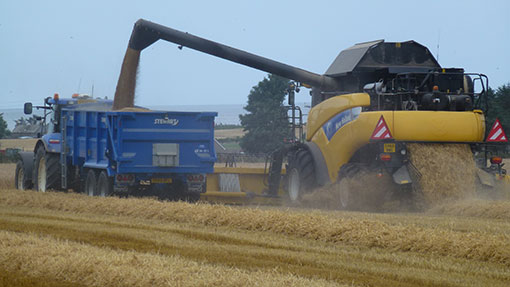Scottish grower sees worst cereal harvest in memory

Many cereal growers saw record harvests in England this summer, but for one north of the border it has been a different picture. Louise Impey reports.
Iain Green has just finished his worst harvest in living memory as heavy rain in his corner of north east Scotland put a dampener on results.
Weather is one of the big obstacles to growing quality cereals on his Morayshire farm and monsoon-like rain in August did not help.
“It’s always a challenge. But this year, we received one third of our annual rainfall in a three-week period in August,” he says.
In one 14-hour period, he saw 104mm of rain followed by a further 100mm almost immediately, which made cutting malting barley very difficult.
As a result, a second four-wheel-drive combine fitted with dual wheels was purchased and scrambled into action so that his spring barley could be cut – all of which had been sold forward.
“Getting a £48/t premium over feed concentrates the mind. We have three customers for our malting barley, all within 10km of the farm,” he adds
Three varieties, which do not produce glycosidic nitrile compounds or non-GNs, favoured by the distilling industry are grown and produce a grain nitrogen content of 1.6% or less.
“This particular distilling market needs a grain nitrogen no higher than 1.6% and the grain must be in good condition, with no splits or skinning,” he says.
For this harvest, the barley has been sold for between £149 and £189/t depending on quality and moisture levels.
The family partnership farms 1,229ha of arable and grassland at Corskie, Garmouth, near Fochabers, close to the mouth of the River Spey in three blocks.
Some 613ha of cereals are grown including winter and spring barley, winter wheat and spring oats, with the spring barley going for distilling.
Barley in Scotland
Some 450,000ha of cereals are growing in Scotland, with spring barley accounting for 270,000ha, of which 90% goes from distilling rather than brewing, says Steve Hoad of the Scotland’s Rural College (SRUC).
Distilling has different requirements to brewing. “It needs bold, starchy grain with an nitrogen content of 1.6% or less,” Dr Hoad adds.
“Until recently, our soft Group 4 wheat was going to a local distillery for white spirit production, which has been a very important market for growers in this area,” he says.
But as the price of wheat went up, the distillers switched to using maize, and then they stuck with it depriving wheat growers of a valuable outlet.
“It’s a worrying development – there are a few distilleries in Scotland which have done the same thing in the past year or so,” Mr Green adds.
While growing spring barley spreads costs, evens out workloads and suits the local climate, winter wheat has been more profitable up until now.
“We aim for 10t/ha from the wheat, but spring barley yields are 6.8-7.5t/ha, depending on the variety,” he says.
Winter barley yields are 9-10t/ha from hybrid six-row varieties. “They’ve performed well here. And the straw is very important to us for our livestock enterprises,” he says
One block of land has been in continuous winter wheat since 1987.
“It’s very good, heavy Grade 2 land and we can maintain 10t/ha from it. So there was no better use for it,” he adds
All the cereal land is ploughed and Mr Green says he would not be able to achieve the same yield with minimum tillage.
“We have tried min-till across the farm, but we ended up with couch problems. So ploughing is back across the board,” he says.
His experience is that seed-bed conditions have a big impact on yield.
“All the cereals are combination drilled, so that the seed and fertiliser is placed together at the same time. That’s fairly unique to north Scotland, but it works very well up here,” Mr Green adds.
The spring barley then receives liquid nitrogen as it is emerging as applications made later cause the grain nitrogen content to be too high.
All of the land has been GPS soil and yield mapped, so that fertiliser and lime can be variably applied and inputs matched to requirements.
A drone has been purchased recently, with the intention of taking precision farming to the next level.
“It’s for hobby use at the moment. But it gives us the ability to capture aerial images, which can then be used for decision making, especially on our outlying farms,” he says.

